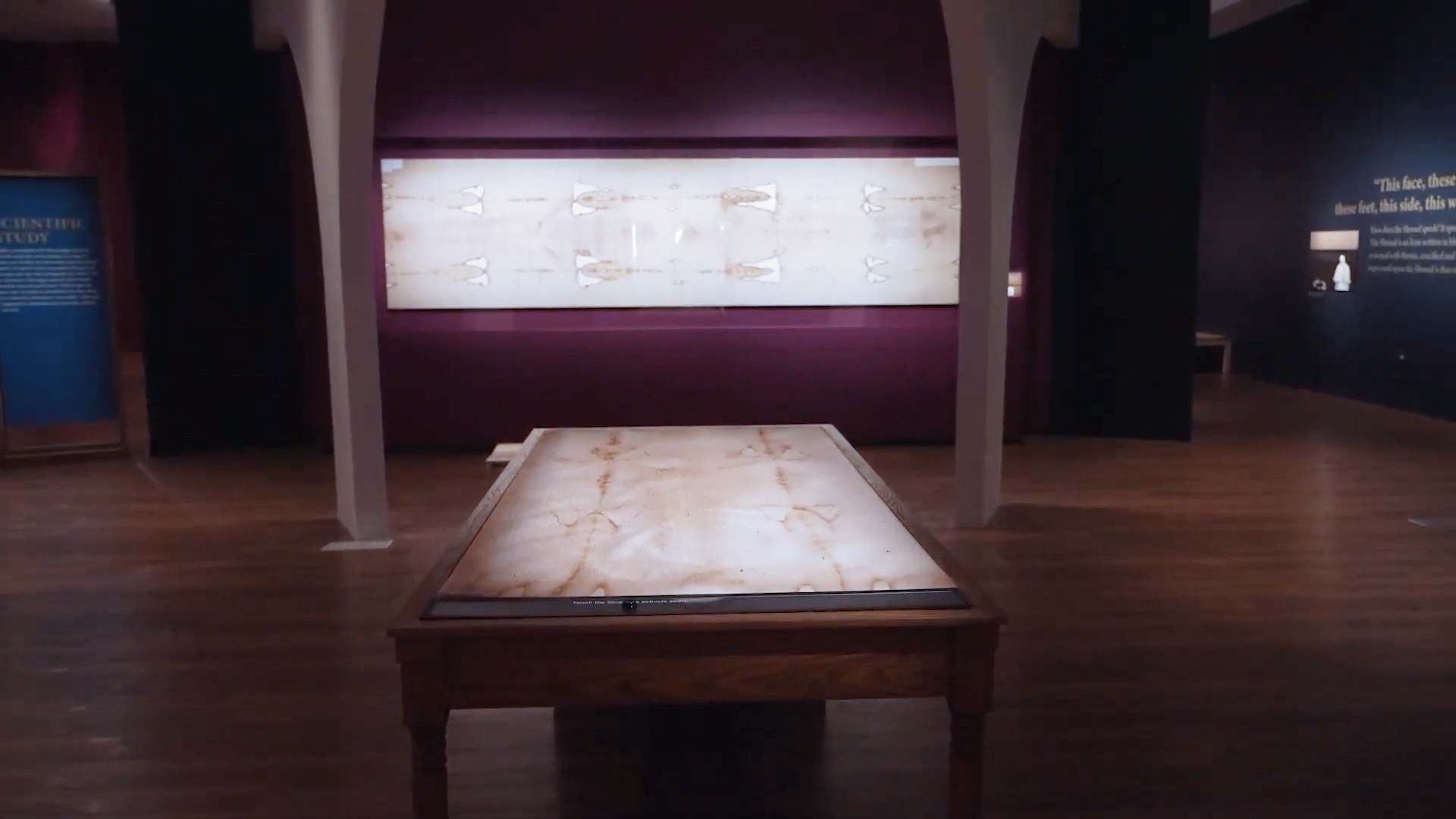
Since it first popped up on history’s radar hundreds of years ago, the Shroud of Turin has captivated scientists, the public, and people of God worldwide. The linen is viewed by some as the burial Shroud of Jesus Christ and others as a medieval forgery.
The story of the piece of cloth is an age-old tale that threads together a centuries old debate about a religious artifact that has survived fires and a series of perils across a journey through history.
The first gaze upon the mysterious relic resembles a Rorschach’s test of damage dating back hundreds if not thousands of years.
Zoom in a little closer, though, and the faint image of a tortured and crucified man comes into focus. Look longer, and the serene face of that man becomes clear.
“It seems so peaceful in comparison to the violence that you see all over the rest of the body,” said Brian Hyland, an exhibit curator at the Museum of the Bible.
In an interview with CBN News, Hyland said that “there have been questions about the veracity of this image ever since its first documented appearance in the late 14th century.”
In 1988, carbon testing dated the Shroud back to medieval times. That test has repeatedly been called into question by various experts.
“The only single sample they took did not represent anywhere else on the cloth because it had been manipulated,” said Barrie Schortz, a Jewish photographer based in Colorado who was called upon to photograph the Shroud in the 1970s.
Now, a new scientific procedure dates fabric from the Shroud to roughly 2,000 years ago. That Italian study is just the latest in a long series of scientific testing, including studies of pollen plucked from the Shroud with a scientific tape dispenser.
“The pollen samples that were gathered they, a lot of them are from plants that are native to not just the Middle East, but specifically the area around Judea, Palestine, and Syria and stay where it was in that time period,” said Hyland.
“There’s also pollen from the area around Constantinople. There’s a lot of pollen from Europe,” he said.
The pollen samples suggest a journey of thousands of miles from Jerusalem, through modern day Turkey, France, and now Italy, where the artifact has been kept since the 16th Century.
Some say the cloth housed in the Turin Cathedral is a vessel for human blood, and therefore may be nothing less than the Holy Grail, an object of some captivation that is said to have gone missing in 1204.
British filmmaker David Rolfe said of the Holy Grail theory, “You realize that the cloth is a vessel that’s containing Christ’s blood. I mean, there it is, and it is blood, and not only is it blood, it is type AB, which is the type that’s consistent with Palestinian Jews.”
Still others call this “bit of linen” a forgery by none other than Leonardo da Vinci. Clive Prince, who along with Lynn Picknett, wrote (ITALICS/LINK) The Turin Shroud: How Leonardo da Vinci Fooled History, said “It’s a 500-year-old photograph by Leonardo da Vinci.”
“And if that doesn’t sound crazy enough, we’re saying it’s a 500-year-old photograph of Leonardo da Vinci because he used his own face as the model, because that’s the kind of thing he did,” Prince added.
The co-authors even put together their own experiments to try and replicate the religious relic using a bust of the Roman emperor Marcus Aurelius. They also compared da Vinci’s disputed Salvator Mundi painting to the image on the Shroud.
Like nearly every theory surrounding the mystery, that, too, is disputed.
“The Shroud has been publicly shown 100 years before da Vinci was born. He was a good artist, but it wasn’t that good,” said Schwortz.
Before Schwortz first photographed the Turin Shroud over four decades ago, he said he was “biased against it,” adding, “I even said somewhere along the line to somebody that, you know, we’ll get to Turin, we’ll give it five minutes, we’ll find the paint, we’ll come home, we’ll be done.”
But there is no paint on this cloth, and there are no brush strokes, and there’s another mystery: it’s 3-D. Scientists using an image analyzer revealed decades ago that the lights and darks of the Shroud image translate into dimensional shapes.
In his fourth film on the subject, “Who Can He Be,” Rolfe, the director, released previous footage showing image analyzing tests. An expert in the film said, “A normal photograph records only variations in light and does not record information about the distance the camera was from the subject.”
Then a photo of the Shroud is put under a VP8 image analyzer. “This image is clearly recognizable,” he says. “This can only be explained if the intensity levels of the Shroud image itself are encoded with distance information from the cloth to the body.”
Now, in “Who Can He Be,” Rolfe’s team uses the latest technology to digitally extract data encoded in the fabric, revealing a three-dimensional model of a man. “We can see what I believe to be the body of the crucified Jesus in front of us,” he said.
Rolfe contends that, “the only way that the image could’ve got on to that cloth is a miraculous one. A miracle that emanated from the body with unbelievable amounts of energy but within an infinitesimally short space of time.”
No matter the evidence, the Shroud of Turin may always remain a mystery. But for many, this “mirror of the gospel,” as Pope John Paul II called it, connects them to the divine.
The Shroud of Turin exhibit at the Musem of the Bible runs through July 31, 2022. For more information, click HERE.
The remainder of this article is available in its entirety at CBN